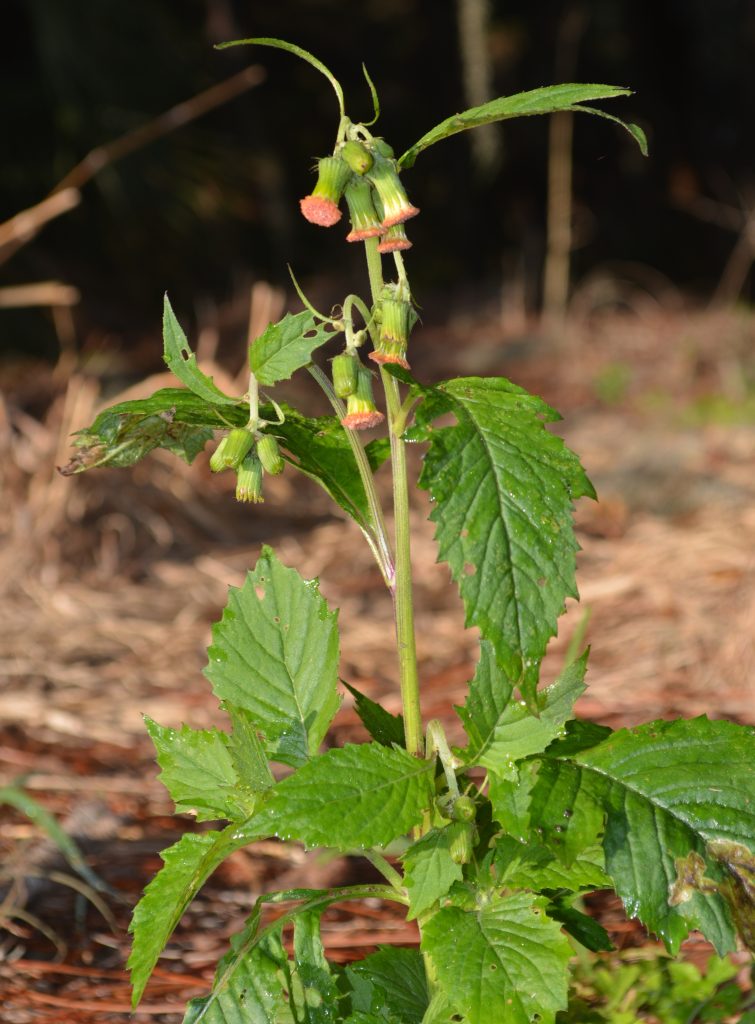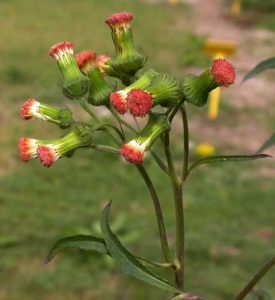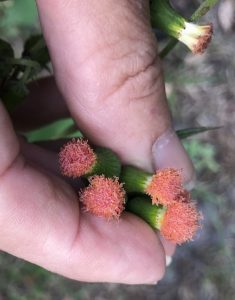
Redflower Ragweed. Photo by Green Deane
The first time I saw Redflower Ragweed I thought I was seeing two species at once some weird combination of Tassel Flower and Fireweed. It’s way too big and has the wrong leaves to be a Tassel Flower but the blossoms remind one of a Tassel Flower but the rests of the plant looks life Fireweed/Burnweed.

The blossoms do resemble the Florida Tassel Flower.
Redflower Ragweed isn’t a “ragweed” as most North Americans know the word. The common ragweed that launches a million sneezes annually is Ambrosia artemisiifolia. Redflower Ragweed is not an Ambrosia. It is Crassocephalum crepidioides (kras-oh-SEF-uh-lum krep-pid-dee-OY-deez.) Crassocephalum is from the Dead Latin “Crassus” meaning “thick” and “kephale” which is Greek for head. Crepidioides is more mangle Greek. “-oides” in Dead Latin is mispronounced borrowed Greek and means “resembles.” Crepidioides means “resembles Crepis.” Crepis is from an old Greek word for a frilly funeral veil. It works its way into English via French as “crepe” paper. So “thick head resembles crepe paper” is one way to interpret the plant’s name.” And even though it is called the Redflower Ragweed its leaves more resemble Fireweed/Burnweed, Erechtites hieraciifolius (which is an even more complicated, naughty story.)

The petalless blossoms are not edible. Photo by Green Deane
This edible shows up in our winter time and lasts until spring or so. I’ve seen it in Largo but this weekend noticed it in Sarasota. It’s actually attractive as weeds go. Cornucopia II says of Crassocephalum crepidioides on page 37: “Ebolo, Okinawan Spinach, Young leaves and shoots are used as a potherb, fried, or mixed in Khao yam. The leaves are fleshy, tinged with purple and have a somewhat mucilaginous quality and nutty flavor. Has become quite popular on the island of Okinawa and in Hawaii In Thailand, the roots are eaten with chili sauce or cooked in fish curry. Tropical Africa. Cultivated.”
Nutritionally the plant is very high in potassium but also sodium. Its relative C. rubens (red) is also edible and higher in nutrition.
Green Deane’s Itemized Plant Profile:
IDENTIFICATION: Erect, sparsely branched, aromatic to 40 inches (100 cm.) Stem ribbed, leaves spiral around the plant, red cylindrical flowers, no petals, which droop as if the plant were low on water.
TIME OF YEAR: In warmer climes in the winter.
ENVIRONMENT: Where ever crops can grow.
METHOD OF PREPARATION: Leaves and young stems cooked.


I noticed in your article ‘Pyrrolizidine on my Mind’ that the Florida Tasselflower, Emilia fosbergii, is probably toxic for your liver. I also noticed that across some different sites, the same photo shows up for Florida Tasselflower AND for Redflower Ragweed. How do you tell them apart? That would be some much appreciated info before I make a big dish of greens out of the wildflowers that have taken over my front yard.
Redflower Ragweed looks like Florida Tassel Flower on steroids. It twice as high and sturdier. It’s a much larger plant and whispy. Also, the blossoms tend to hang down in a cluster.
Hi,
I was so delighted to read this article about Redflower Ragleaf. I have been looking for the seeds so that I can plant them. I remember eating them long time ago. Please kindly let me know where to buy the seeds.
Thanks,
John
I was so delighted to read this article about Redflower Ragleaf. I have been looking for the seeds so that I can plant them. I remember eating them long time ago. Please kindly let me know where to buy the seeds.